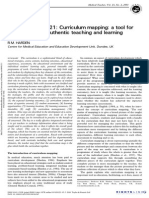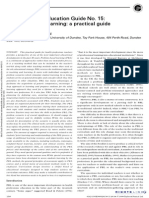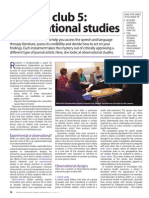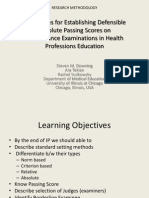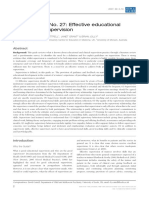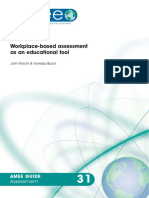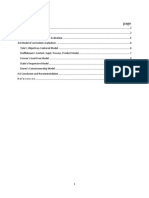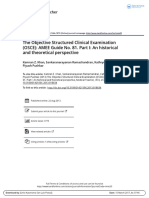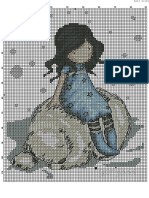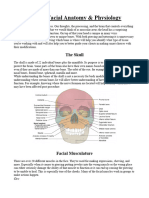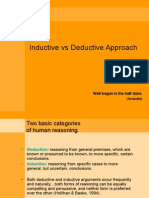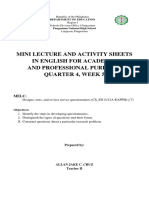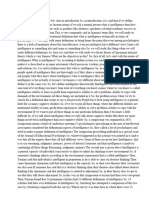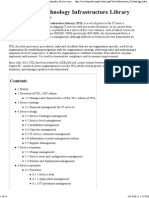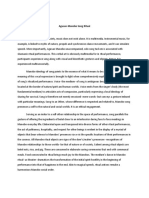How To Design A Questionnaire
How To Design A Questionnaire
Uploaded by
Mithun SahaCopyright:
Available Formats
How To Design A Questionnaire
How To Design A Questionnaire
Uploaded by
Mithun SahaOriginal Description:
Original Title
Copyright
Available Formats
Share this document
Did you find this document useful?
Is this content inappropriate?
Copyright:
Available Formats
How To Design A Questionnaire
How To Design A Questionnaire
Uploaded by
Mithun SahaCopyright:
Available Formats
Education
How to design a questionnaire
Wai-Ching Leung has some practical advice on questionnaires
As discussed in a previous issue a survey involves directly collecting information from people (or sometimes organisations) whom we are interested in.1 The types of information will take account of the peoples or organisations level of knowledge, attitude, personalities, beliefs, or preferences. Questionnaires are widely used to collect such information. Well designed questionnaires are highly structured to allow the same types of information to be collected from a large number of people in the same way and for data to be analysed quantitatively and systematically. Questionnaires are best used for collecting factual data and appropriate questionnaire design is essential to ensure that we obtain valid responses to our questions.
Objectives in designing questionnaires
There are two main objectives in designing a questionnaire: q To maximise the proportion of subjects answering our questionnairethat is, the response rate. q To obtain accurate relevant information for our survey. To maximise our response rate, we have to consider carefully how we administer the questionnaire, establish rapport, explain the purpose of the survey, and remind those who have not responded. The length of the questionnaire should be appropriate. In order to obtain accurate relevant information, we have to give some thought to what questions we ask, how we ask them, the order we ask them in, and the general layout of the questionnaire.
dependent factors include the students level of relevant knowledge, skills, and attitudes. The independent factors might include students learning styles, GCSE and A level grades, socioeconomic status, ethnicity, etc. Confounding variables might include the types and quality of teaching in each medical school. Sometimes, additional questions are used to detect the consistency of the subjects responses. For example, there may
be a tendency for some to tick either agree or disagree to all the questions. Additional contradictory statements may be used to detect such tendencies.
Wording of individual questions
The way questions are phrased is important and there are some general rules for constructing good questions in a questionnaire.
Use short and simple sentences
Box 1: Advantages of open or closed format
Open format
Allows exploration of the range of possible themes arising from an issue Can be used even if a comprehensive range of alternative choices cannot be compiled
Deciding what to ask
As discussed in last months issue, there are three potential types of information: q Information we are primarily interested inthat is, dependent variables. q Information which might explain the dependent variablesthat is, independent variables. q Other factors related to both dependent and independent factors which may distort the results and have to be adjusted forthat is, confounding variables. Let us take as an example a national survey to find out students factors predicting the level of certain knowledge, skills, and attitudes at the end of their undergraduate medical course. The
STUDENT BMJ VOLUME 9 JUNE 2001 studentbmj.com
Short, simple sentences are generally less confusing and ambiguous than long, complex ones. As a rule of thumb, most sentences should contain one or two clauses. Sentences with more than three clauses should be rephrased.
Ask for only one piece of information at a time
For example, Please rate the lecture in terms of its content and presentation asks for two pieces of information at the same time. It should be divided into two parts: Please rate the lecture in terms of (a) its content, (b) its presentation.
Closedthat is, forced choiceformat
Easy and quick to fill in Minimise discrimination against the less literate (in self administered questionnaire) or the less articulate (in interview questionnaire) Easy to code, record, and analyse results quantitatively Easy to report results
Avoid negatives if possible
Negatives should be used only sparingly. For example, instead of asking students whether they agree with the statement,
187
Education
Small group teaching should not be abolished, the statement should be rephrased as, Small group teaching should continue. Double negatives should always be avoided.
Ask precise questions
Questions may be ambiguous because a word or term may have a different meaning. For example, if we ask students to rate their interest in medicine, this term might mean general medicine (as opposed to general surgery) to some, but inclusive of all clinical specialties (as opposed to professions outside medicine) to others. Another source of ambiguity is a failure to specify a frame of reference. For example, in the question, How often did you borrow books from your library? the time reference is missing. It might be rephrased as, How many books have you borrowed from the library within the past six months altogether?
approach: Please tick one or more of the following items which correspond to how you have answered degree examination questions in the past. In the list of items, include copy from other students as one of many items. Thirdly, the everybody approach: As we all know, most medical students have copied other students answers in degree exams. Do you happen to be one of them? Fourthly, other people approach. This approach was used in the recent medical student survey.3 In this survey, students were given the scenario, John copies answers in a degree exam from Jean. They were then asked, Do you feel John is wrong, what penalty should be imposed for John, and have you done or would you consider doing the above?
Minimise bias
People tend to answer questions in a way they perceive to be socially desired or expected by the questioner and they often look for clues in the questions. Many apparently neutral questions can potentially lead to bias. For example, in the question, Within the past month, how many lectures have you missed due to your evening job? students may perceive the desired responses to be never to the first question. This question could be rephrased as, Within the past month, how many times did your evening job commitment clash with lectures? How many times did you give priority to your evening job? Take another example. The question, Please rate how useful the following text-
Box 2: Types of closed (forced choice) format
Choice of categories For example, What is your marital status? [ ] Single [ ] Married [ ] Divorced [ ] Widowed Likert style scale For example, Statistics is an interesting subject
Strongly disagree Disagree Cannot decide Agree Strongly agree
Ensure those you ask have the necessary knowledge
For example, in a survey of university lecturers on recent changes in higher education, the question, Do you agree with the recommendations in the Dearing report on higher education? is unsatisfactory for several reasons. Not only does it ask for several pieces of information at the same time as there are several recommendations in the report, the question also assumes that all lecturers know about the relevant recommendations.
Differential scales For example, How would you rate the presentation?
Extremely interesting 1 2 3 4 5 6 7 8 9 10 Extremely dull It may also be diagrammatic:
Level of details
It is important to ask for the exact level of details required. On the one hand, you might not be able to fulfil the purposes of the survey if you omit to ask essential details. On the other hand, it is important to avoid unnecessary details. People are less inclined to complete long questionnaires. This is particularly important for confidential sensitive information, such as personal financial matters or marital relationship issues.
Extremely interesting Extremely dull
Checklists For example, Circle the clinical specialties you are particularly interested in
General medicine General surgery Ophthalmology Paediatrics Obstetrics and gynaecology Orthopaedics Accident and emergency General practice
Sensitive issues
It is often difficult to obtain truthful answers to sensitive questions. Clearly, the question, Have you ever copied other students answers in a degree exam? is likely to produce either no response or negative responses. Less direct approaches have been suggested.2 Firstly, the casual approach: By the way, do you happen to have copied other students answers in a degree exam? may be used as a last part of another decoy question. Secondly, the numbered card
188
Ranking For example, Please rank your interests in the following specialties (1= most interesting, 8=least interesting)
General medicine General surgery Ophthalmology Paediatrics Obstetrics and gynaecology Orthopaedics Accident and emergency General practice
STUDENT BMJ VOLUME 9
JUNE 2001 studentbmj.com
Education
books are. Please also state whether they are included in your lecturers recommended reading list? There is a risk that the students may perceive that they should rate books recommended by lecturers more favourably than those not recommended by their lecturers. This risk may be minimised by putting the second question later on in the questionnaire.
every question. Filter questions are useful to ensure that respondents answer only relevant questions. However, avoid a highly complex filter regime. Make good use of arrows and boxes to clarify the filter regime.
Introduction, personalised letter, and ending
It seems a good idea to have either a personalised covering letter or at least an introduction explaining briefly the purpose of the survey, the importance of the respondents participation, who is responsible for the survey, and a statement guaranteeing confidentiality.5 A personalised letter can be easily generated using mail-merge on a word processor. It is also important to thank the respondent at the end of the questionnaire.
Format of responses
The responses can be in open or closed formats. In an open ended question, the respondents can formulate their own answers. In closed format, respondents are forced to choose between several given options. The advantages of each of these formats are shown in box 1. It is possible to use a mixture of the two formatsfor example, give a list of options, with the final option of other followed by a space for respondents to fill in other alternatives. There are several forced choice formats. These are shown in box 2. Out of these formats, ranking is probably least frequently used, as the responses are relatively difficult to record and analyse.
How to administer the questionnaires
There are several ways of administering questionnaires. They may be self administered or read out by interviewers. Self administered questionnaires may be sent by post, email, or electronically online. Interview administered questionnaires may be by telephone or face to face. Advantages of self administered questionnaires include: q Cheap and easy to administer. q Preserve confidentiality. q Can be completed at respondents convenience. q Can be administered in a standard manner.
Length of questionnaire
There are no universal agreements about the optimal length of questionnaires. It probably depends on the type of respondents. However, short simple questionnaires usually attract higher response rates than long complex ones. In a BMJ survey of stroke survivors both the response rate and the proportion of completed forms were higher for a shorter questionnaire (six questions with a visual analogue scale) compared with a longer and more complex questionnaire (with 34 questions).4
might ask each respondent in great detail about a limited number of questions: effects of different wordings, what they have in mind when they give a particular answer, how they understand a particular word, etc. In the second phase the whole questionnaire is administered by interviewers. Analysis of the responses and the interviewers comments are used to improve the questionnaire. Ideally, there should be sufficient variations in responses among respondents; each question should measure different qualitiesthat is, the responses between any two items should not be very strongly correlated and the non-response rate should be low. In the third phase the pilot test is polished to improve the question order, filter questions, and layout.
Conclusions
Questionnaires must be carefully designed to yield valid information. Meticulous attention must be paid to ensure that individual questions are relevant, appropriate, intelligible, precise, and unbiased. The order of the questions must be carefully arranged, and the layout of the questionnaire must be clear. It is wise to draft a clear personalised covering letter. Questionnaires must first be piloted and evaluated before the actual survey.
Advantages of interview administered questionnaires include:
Allow participation by illiterate people. Allow clarification of ambiguity. The exact method of administration also depends on who the respondents are. For example, university lecturers may be more appropriately surveyed by email; older people by telephone interviews; train passengers by face to face interviews.
q q
Arranging the questions
The order of the questions is also important. Some general rules are: q Go from general to particular. q Go from easy to difficult. q Go from factual to abstract. q Start with closed format questions. q Start with questions relevant to the main subject. q Do not start with demographic and personal questions. It is useful to use a variety of question format as shown in box 2 to maintain the respondents interest. When a series of semantic differential scales are used, it may be a good idea to mix positive negativefor example, interesting to dullwith negative positivefor example, useless to usefulscales. This might make the respondents think more and avoid the tendency to tick the same response for
STUDENT BMJ VOLUME 9 JUNE 2001 studentbmj.com
Further reading:
Abramson JH, Abramson ZH. Survey methods in community medicine. Edinburgh: Churchill Livingstone, 1999. Bowling A. Research methods in health: investigating health and health services. Buckingham: Open University Press, 1997.
Piloting and evaluation of questionnaires
Given the complexity of designing a questionnaire, it is impossible even for the experts to get it right the first time round. Questionnaires must be pretestedthat is, pilotedon a small sample of people characteristic of those in the survey. In a small survey, there might be only pretesting of the drafted questionnaire. In a large survey, there may be three phases of piloting. In the first phase we
Wai-Ching Leung lecturer in public health medicine, University of East Anglia
w-c.leung@uea.ac.uk 1 2 3 Leung WC. How to conduct a survey. StudentBMJ 2001;9:143-5. (May.) Barton JA. Asking the embarrassing question. Public Opinion Quarterly 1958;22:67-8. Rennie SC, Crosby JR. Are tomorrows doctors honest? Questionnaire study exploring medical students attitudes and reported behaviour in academic misconduct. studentBMJ 2001;9:67-8.(March.) Dorman PJ, Slattery J, Farrell B, Dennis MS, Sandercock PAG. A randomised comparison of the EuroQol and Short Form-36 after stroke. BMJ 1997;315:461. Bissett AF. Designing a questionnaire: Send a personal covering letter. BMJ 1994;308:202-3.
189
You might also like
- Basic Electrical Engineering: PressDocument13 pagesBasic Electrical Engineering: PressArjun Narayanan SatchidanandamNo ratings yet
- AP Research Survival Guide - RevisedDocument58 pagesAP Research Survival Guide - RevisedBadrEddin IsmailNo ratings yet
- AMEE GUIDE 49, How To Measure The Quality of The OSCEDocument10 pagesAMEE GUIDE 49, How To Measure The Quality of The OSCEyuestiNo ratings yet
- AMEE Guide No. 4 Effective Continuing Education - The CRISIS CriteriaDocument16 pagesAMEE Guide No. 4 Effective Continuing Education - The CRISIS CriteriaaungNo ratings yet
- Pre-Calculus: Quarter 2 - Module 3Document21 pagesPre-Calculus: Quarter 2 - Module 3Cesa BuhianNo ratings yet
- Journal Club 2: Qualitative ResearchDocument4 pagesJournal Club 2: Qualitative ResearchSpeech & Language Therapy in Practice100% (1)
- Journal Club 4: Intervention StudiesDocument4 pagesJournal Club 4: Intervention StudiesSpeech & Language Therapy in PracticeNo ratings yet
- Lecture 5 Cartilage and BoneDocument3 pagesLecture 5 Cartilage and BoneRazmine RicardoNo ratings yet
- AMEE 44 The Use of Reflection in Medical EducationDocument12 pagesAMEE 44 The Use of Reflection in Medical EducationYossi Indra KusumaNo ratings yet
- Journal Club 6: Single Subject DesignsDocument4 pagesJournal Club 6: Single Subject DesignsSpeech & Language Therapy in PracticeNo ratings yet
- AMEE Guide Theories Used in AssessmentDocument15 pagesAMEE Guide Theories Used in AssessmentalmoslihNo ratings yet
- AMEE Guide 21 - Curriculum Mapping PDFDocument15 pagesAMEE Guide 21 - Curriculum Mapping PDFRehan AsadNo ratings yet
- AMEE Guide 15 Problem-Based LearningDocument11 pagesAMEE Guide 15 Problem-Based LearningalmoslihNo ratings yet
- Journal Club 5: Observational StudiesDocument4 pagesJournal Club 5: Observational StudiesSpeech & Language Therapy in PracticeNo ratings yet
- General Overview of The Theories Used in AssessmentDocument16 pagesGeneral Overview of The Theories Used in Assessmentgus_lionsNo ratings yet
- Game Elements Improve Performance in A Working Memory Training TaskDocument15 pagesGame Elements Improve Performance in A Working Memory Training TaskLannyyeeeNo ratings yet
- Test Blueprinting II: Creating A Test BlueprintDocument10 pagesTest Blueprinting II: Creating A Test BlueprintDr. Doaa El MorsiNo ratings yet
- Journal Club 3: Systematic ReviewsDocument4 pagesJournal Club 3: Systematic ReviewsSpeech & Language Therapy in PracticeNo ratings yet
- Standard Setting ProceduresDocument41 pagesStandard Setting ProceduresRizwan Zafar Ansari100% (1)
- 2 - Regulation For The Appoinment - Promotions of FacultyDocument24 pages2 - Regulation For The Appoinment - Promotions of FacultyForumliker Khan100% (1)
- The What How and Why of Storytelling PDFDocument24 pagesThe What How and Why of Storytelling PDFSofia LeviNo ratings yet
- Amee Supervision GuideDocument20 pagesAmee Supervision GuideZulkifli S LasombaNo ratings yet
- Session 5 Guide 31 Workplace Based AssessmentDocument21 pagesSession 5 Guide 31 Workplace Based AssessmentRiry AmbarsaryNo ratings yet
- E-Learning, AMEE Guide 32Document19 pagesE-Learning, AMEE Guide 32BayuA Praditya IndartoNo ratings yet
- Curriculum Evaluation ModelsDocument16 pagesCurriculum Evaluation ModelsRonald MatnogNo ratings yet
- AMEE Guide 20 - The Twelve Roles of The Teacher PDFDocument14 pagesAMEE Guide 20 - The Twelve Roles of The Teacher PDFIndah Utami P SNo ratings yet
- Handout 1 StatisticsDocument21 pagesHandout 1 StatisticsJaymar MagtibayNo ratings yet
- Quantitative and Qualitative Methods in Medical Education Research - AMEE Guide No 90 - Part IDocument11 pagesQuantitative and Qualitative Methods in Medical Education Research - AMEE Guide No 90 - Part IYossi Indra KusumaNo ratings yet
- The Objective Structured Clinical Examination OSCE AMEE Guide No 81 Part I An Historical and Theoretical PerspectiveDocument11 pagesThe Objective Structured Clinical Examination OSCE AMEE Guide No 81 Part I An Historical and Theoretical PerspectivedkasisNo ratings yet
- What Is RhabdomyosarcomaDocument3 pagesWhat Is RhabdomyosarcomaAndi.Roem_97No ratings yet
- Curriculum & Course DesignDocument4 pagesCurriculum & Course DesignGhulam MujtabaNo ratings yet
- AMEE Guide 08 Learning in Small GroupDocument22 pagesAMEE Guide 08 Learning in Small Groupalmoslih100% (1)
- Concept Maps in Education PDFDocument17 pagesConcept Maps in Education PDFINKUD AGRITAMA100% (1)
- Winter Friend Xg8 Bothy ThreadsDocument4 pagesWinter Friend Xg8 Bothy ThreadsEvelina Tomonyte100% (1)
- Statistics NotesDocument46 pagesStatistics Noteshsrinivas_7No ratings yet
- Skull AnatomyDocument8 pagesSkull Anatomyjellymot3474No ratings yet
- Deduction vs. InductionDocument18 pagesDeduction vs. InductionNatasha HussainNo ratings yet
- How To Design A QuestionnaireDocument3 pagesHow To Design A QuestionnaireBaber Mirza (Prof.Baber)No ratings yet
- Bryman5Ce SSG Ch05Document13 pagesBryman5Ce SSG Ch05Mayuri BahugunaNo ratings yet
- 8604 Assessment 2Document49 pages8604 Assessment 2Ahsan KhanNo ratings yet
- Research Instrument, Validation and Test of ReliabilityDocument13 pagesResearch Instrument, Validation and Test of ReliabilityKimverlee Anne Garcia100% (1)
- Melakukan Survei RisetDocument4 pagesMelakukan Survei RisetWidya NingsihNo ratings yet
- Adiba Survey Research ReportDocument65 pagesAdiba Survey Research Reportadiba KhanNo ratings yet
- Ppt in English 4Document27 pagesPpt in English 4jmg81322No ratings yet
- Designing A Good QuestionnaireDocument4 pagesDesigning A Good QuestionnaireVanderlee PinatedNo ratings yet
- Characteristics of Good ResearchDocument72 pagesCharacteristics of Good ResearchNanette A. Marañon-SansanoNo ratings yet
- What Is A Research ProblemDocument5 pagesWhat Is A Research ProblemArsyilia NabilaNo ratings yet
- Principles Forms DesignDocument4 pagesPrinciples Forms DesignKevin Gail Ocampo BasaNo ratings yet
- PR2 4th Week 1st MeetingDocument19 pagesPR2 4th Week 1st MeetingcaspitdiannaNo ratings yet
- Research QuestionsDocument13 pagesResearch QuestionsRonald Hernando NacionNo ratings yet
- Advance Planning Techniques: Questionnaire Design Types of Data Sampling MethodDocument14 pagesAdvance Planning Techniques: Questionnaire Design Types of Data Sampling MethodhimaniwatalNo ratings yet
- Research QuestionnaireaaruuuuuuDocument10 pagesResearch QuestionnaireaaruuuuuuArjumand ZargarNo ratings yet
- Colegio de La Purisima Concepcion: Questionnaire Preparation - GuidelinesDocument4 pagesColegio de La Purisima Concepcion: Questionnaire Preparation - GuidelinesNathelyn InoNo ratings yet
- Research HypothesisDocument7 pagesResearch HypothesisSherwin Jay BentazarNo ratings yet
- part 5Document2 pagespart 5JeffreyNo ratings yet
- Techniques of Data CollectionDocument73 pagesTechniques of Data Collectionnavkiratsingh1019No ratings yet
- Lesson 11Research QuestionDocument4 pagesLesson 11Research QuestionsvalenzuelaNo ratings yet
- Q2-EAPP-4-Survey Questionnaire (1)Document25 pagesQ2-EAPP-4-Survey Questionnaire (1)bedoniasherlitaNo ratings yet
- Mini Lecture and Activity Sheets in English For Academic and Professional Purposes Quarter 4, Week 5Document11 pagesMini Lecture and Activity Sheets in English For Academic and Professional Purposes Quarter 4, Week 5EllaNo ratings yet
- What Takes Place in A Prelim?Document4 pagesWhat Takes Place in A Prelim?Syed AliNo ratings yet
- Lesson 7 Module2Document29 pagesLesson 7 Module2BOBBY BRAIN ANGOSNo ratings yet
- BRM AssignmentDocument6 pagesBRM AssignmentHohaho YohahaNo ratings yet
- Term Paper 301Document20 pagesTerm Paper 301Mithun SahaNo ratings yet
- Training & Development at L&TDocument40 pagesTraining & Development at L&Tnishant128957% (7)
- Indian Banking SystemDocument10 pagesIndian Banking SystemMithun SahaNo ratings yet
- Smart SurveyDocument36 pagesSmart SurveynizarazuNo ratings yet
- Cfdcir 0104Document18 pagesCfdcir 0104dashashutosh87No ratings yet
- Parts Details LPG Compressors 3Document40 pagesParts Details LPG Compressors 3mohsen17183No ratings yet
- Module 1: Flywheel Outcomes: Me 413A - Machine Design 2 (Isat U Lecture Notes)Document8 pagesModule 1: Flywheel Outcomes: Me 413A - Machine Design 2 (Isat U Lecture Notes)Geoffrey Golbeque100% (1)
- DLP in Math 8 ShainaDocument12 pagesDLP in Math 8 ShainaZandra QuillaNo ratings yet
- Guidance For The Safe Operation of Liquid Nitrogen Food FreezersDocument4 pagesGuidance For The Safe Operation of Liquid Nitrogen Food FreezersDaniel SetyadiNo ratings yet
- mpc01 Block2Document56 pagesmpc01 Block2mindbright085No ratings yet
- Set 1 HandoutsDocument11 pagesSet 1 HandoutsPraba KaranNo ratings yet
- Sensorless Parameters Estimation of VFD Based CascDocument14 pagesSensorless Parameters Estimation of VFD Based CascAnonymous 1AAjd0No ratings yet
- Pompe IncendiuDocument3 pagesPompe IncendiuMilimilimanimo ManimanimilimoNo ratings yet
- IELTS Task 2 First Ingredient Task AchievementDocument7 pagesIELTS Task 2 First Ingredient Task AchievementKay Chan SothearaNo ratings yet
- FlowCon Green3 Tech NoteDocument6 pagesFlowCon Green3 Tech NoteAnonymous 6hptH95No ratings yet
- Information Technology Infrastructure Library - Wikipedia, The Free EncyclopediaDocument24 pagesInformation Technology Infrastructure Library - Wikipedia, The Free EncyclopediaGangi Reddy NallagonduNo ratings yet
- Manobo Song RitualDocument2 pagesManobo Song RitualMary Cris J. TabalanzaNo ratings yet
- Dinamica FabrilDocument96 pagesDinamica FabrilCarlosLopezNo ratings yet
- Nyaya Part 5Document5 pagesNyaya Part 5Anshu ResearchNo ratings yet
- Heat Transfer Interview QuestionsDocument7 pagesHeat Transfer Interview QuestionsbsomashekarbNo ratings yet
- Extended Writing - ArticleDocument20 pagesExtended Writing - Articleazliza yunusNo ratings yet
- Introduction To The World of Computers: Computer - Chapter OneDocument9 pagesIntroduction To The World of Computers: Computer - Chapter OneAhmed NaserNo ratings yet
- Indian Standard: Ac Generators Driven Reciprocating Internal Combustion Engines - SpecificationDocument14 pagesIndian Standard: Ac Generators Driven Reciprocating Internal Combustion Engines - Specificationt k s sri ramanNo ratings yet
- Helical AntennaDocument7 pagesHelical AntennaSushanth reddyNo ratings yet
- Iex 3e Intermediate Tests U7Document4 pagesIex 3e Intermediate Tests U7Martyna CegiełkaNo ratings yet
- Gen Chem Homeworks DagilimDocument4 pagesGen Chem Homeworks DagilimSefa Ceren KANDEMİRNo ratings yet
- JAsolar JAM72D09BP PDFDocument2 pagesJAsolar JAM72D09BP PDFsrg2No ratings yet
- Analysing Extended UrbanizationDocument24 pagesAnalysing Extended Urbanizationonuracar82No ratings yet
- EN - Inverter Split System Model EXH09HL1W PDFDocument62 pagesEN - Inverter Split System Model EXH09HL1W PDFIdenilson SilvaNo ratings yet
- 1592020110 XR01-02CX GB r1.2 16.01.13Document3 pages1592020110 XR01-02CX GB r1.2 16.01.13VIGNESH N RNo ratings yet
- Impact of Feed Properties On The FCC UnitDocument7 pagesImpact of Feed Properties On The FCC UnitlorenaNo ratings yet
- Second Language Learning JourneyDocument2 pagesSecond Language Learning JourneyMalakNo ratings yet
- Im 305 Seminar Case ThreeDocument2 pagesIm 305 Seminar Case Threemguumnene29No ratings yet











